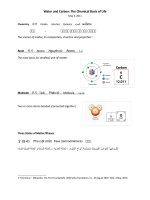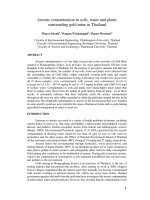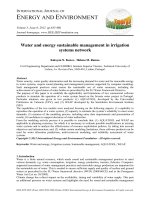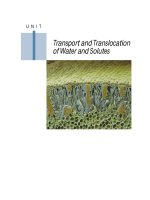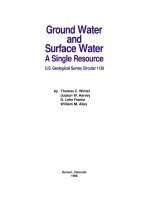WATER AND MINERALS
Bạn đang xem bản rút gọn của tài liệu. Xem và tải ngay bản đầy đủ của tài liệu tại đây (595.92 KB, 46 trang )
FCNS 201 SECTION 1
HUMAN NUTRITION
CHAPTER 9
WATER AND MINERALS
Joan Quinn, MEd., RD, LD
LEARNING OBJECTIVES
1. Discuss the major roles of water in the
body and the amount of water needed by
adults
2. Describe how the body regulates water
intake and excretion to maintain water
balance.
LEARNING OBJECTIVES,
cont.
3. Compare the arguments for and
against drinking bottled water.
4. Explain the role of minerals in
maintaining the body’s fluid and
electrolyte balance.
LEARNING OBJECTIVES,
cont.
5. List the major roles and important
deficiency and toxicity symptoms for each
major and trace mineral.
6. List good food sources for the major
and trace minerals
MINERAL TRIVIA
4% of adult weight is mineral
There are 21 essential known minerals,
including copper, zinc, and of course iron
Body tolerances vary widely, with some
minerals having very narrow lines
between deficiency and toxicity
MINERAL CLASSIFICATION
Major Minerals
Trace Minerals
♦ Calcium
♦ Phosphorus
♦ Magnesium
♦ Sodium
♦ Potassium
♦ Chloride
♦ Sulfur
♦ Iron
♦ Iodine
♦ Zinc
♦ Copper
♦ Selenium
♦ Chromium
♦ Fluoride
GENERAL MINERAL
FUNCTIONS
Acid Base Balance
Cofactors in enzyme reactions
Components of essential body
compounds-blood, bone
Water balance
Transmission of nerve impulses
Regulation of muscle contractions
Growth
Bioavailability
Not all ingested minerals can be fully
absorbed
Animal products are better absorbed
♦ Fiber Mineral interactions
♦ Mineral-Mineral interactions
♦ Vitamin-mineral interactions
♦ Mineral toxicities
Toxicity of Minerals
Trace minerals
Usually through supplementation
Risk of contamination
THE MAJOR MINERALS
> 100 MG/DAY
Calcium, phosphorus,
magnesium, sodium,
potassium, chloride, sulfur
FUNCTIONS OF CALCIUM
Bone and tooth formation
Blood clotting
Muscle contractions
Transmission of nerve impulses
Cell metabolism
ABSORPTION OF CALCIUM
Requires Vitamin D
Factors favoring absorption
♦ Vitamin D
♦ GI Acidity
♦ Need for Ca
About 25% of food calcium absorbed
♦ Up to 60% when need is high
ABSORPTION OF CALCIUM
Factors decreasing absorption
♦ Phytic Acid in grains
♦ Excess Dietary Protein
♦ Tannins in tea
♦ Vitamin D deficiency
♦ Menopause
♦ Diarrhea
♦ Old Age
Food Sources of Calcium
Dairy products
Kale, collard, mustard greens
Calcium fortified foods
Tofu (if made with calcium carbonate)
Canned fish
Daily Value is 1000 mg/day
Adequate Intake is 1000 -1200 mg/day for
adults
Current intake is below the AI
Abnormalities of CA
Metabolism
Osteoporosis-failure to maintain bone
mass not related to Vitamin D deficiency,
drug interactions or cancer
Tetany-inability to relax muscles after
contraction
Osteoporosis
Decrease bone mass
Related to aging, poor diet, and hormone
Leads to 1.5 million bone fractures per
year
Slender, inactive women who smoke is at
highest risk
Type I (postmenopausal)
Type II (senile)
Bone Strength
Depends on bone mass and bone mineral
density
Related to age, gender, and genetics
Peak Bone Mass achieved by age 20-30
Dual Energy X-ray Absorption (DEXA)
bone scan
Prevention of Osteoporosis
Achieve AI for Calcium from childhood on
Don’t smoke
Weight bearing exercise
Rule of 300
300 mg of calcium from various foods
consumed throughout the day
Additional 300 mg for every cup of
milk/yogurt
Calcium Supplement
Recommended for people who cannot
incorporate dairy into their diets
Not recommended with high iron meal
Calcium carbonate
♦ For those with ample of stomach acid
♦ Found in antacids
Calcium citrate
♦ Enhance absorption due to acidity content
♦ Recommended for elderly
Risks With Supplements
No FDA regulation
Oyster shell
Bone meal and lead
Look for United States Pharmacopoeia seal
of approval
Too Much Calcium
Kidney stones/failure
Calcium in the urine
High calcium in the blood
Calcification of tissue
Upper level set at 2500 mg/day
